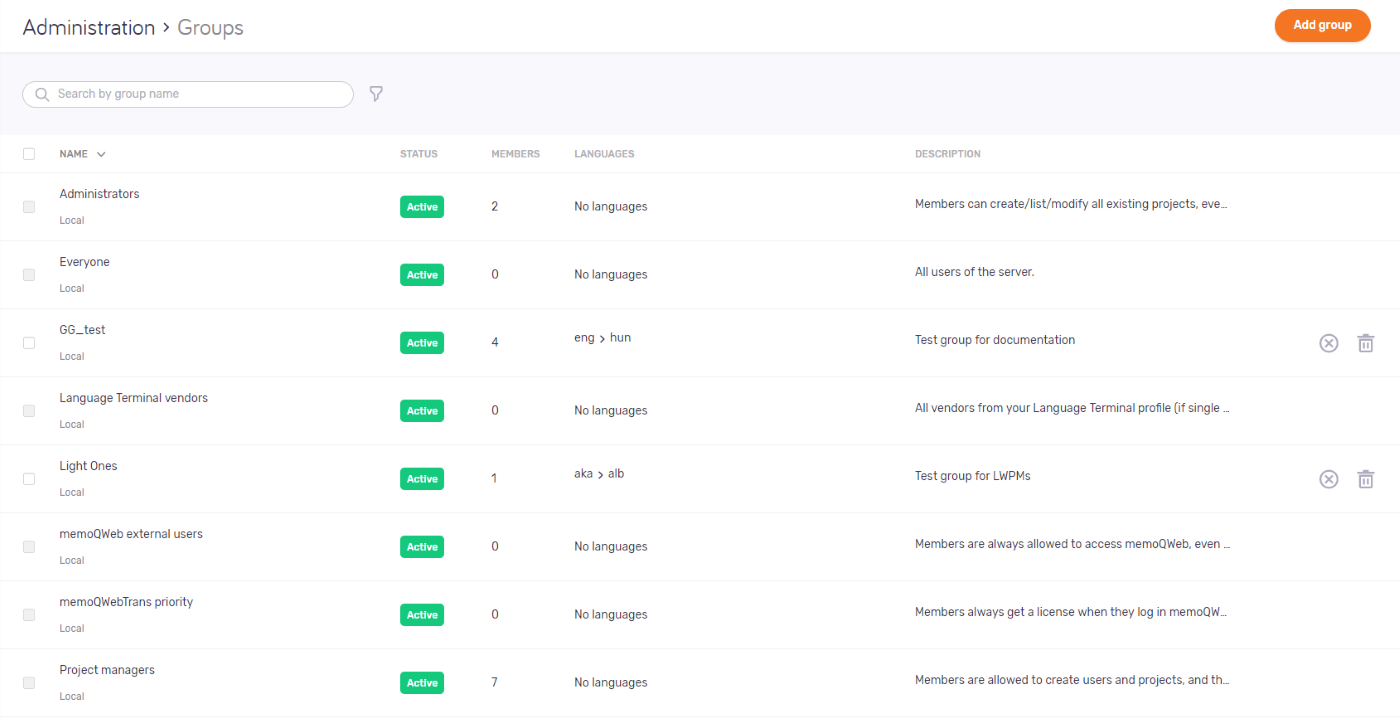Administration > Groups
You can manage the groups who have access to the resources (translation memories, term bases, etc.) and projects on the memoQ TMS. Create new groups, modify group descriptions, delete groups, or add/remove users in a group.
How to get here
- Log in to memoQweb as an administrator or a project manager.
- On the left sidebar, click the Admin
 icon.
icon. -

What can you do?
Project managers can do less: In the topic below, an asterisk (*) marks the features that PMs can use.
Learn about built-in groups
memoQ TMS comes with the following built-in groups:
-
Administrators: Members can create and modify projects, even those where they are not added as project manager. They can create, edit or delete translation memories, term bases and other resources. They can create and manage users and groups. They can change all of the the server's settings.
-
Everyone: Every user on the server is member of this group.
-
In-country reviewers: Members (typically subject matter experts) can use the In-country review tool to for checking translated documents to ensure that their flow and context are correct. They cannot use the webtrans translation editor to open documents. This is an exclusive group: its members cannot be in any other built-in group.
-
Internal translators: Members can check out online projects. They can see and use translation memories and other resources if they have permission. Normally, a new resource allows Internal translators to access it.
-
memoQweb external users: If your client appoints people to work with terminology on the Qterm terminology management system, place their user accounts in this group.
-
webtrans priority: Members of this group always get a license when they log in to memoQweb, even if that means taking a license away from another user. Ideal for customers who should always be served first.
-
Project managers: Members are allowed to create users and projects, and they can create, edit, or delete translation memories, term bases and other resources on the server.
-
Publishers: Members are allowed to share local resources on the memoQ TMS.
-
Resource lookup via API/plugins: If there are users who access translation memories from a different tool, place them in this group. Members have read-only access to translation memories and term bases from plugins that use memoQ TMS's API. An example is the translation memory plugin for Trados Studio. Members can only access those resources where they also have explicit permission.
-
Resource update via API/plugins: If there are users who need to update translation memories from a different tool, place them in this group. Members have read and write access to translation memories and term bases from plugins that use memoQ TMS's API. An example is the translation memory plugin for Trados Studio. Members can only access those resources where they also have explicit permission.
-
Terminologists: Members can approve changes in moderated term bases; they can list and use term bases created with default permissions.
Search or filter the group list *
Create a new group
In the top right corner, click the Add group button. The Add group screen opens.
Edit a group *
In the Name list, click a group. The Edit group screen opens.
Project managers can:
- Add or remove members of the Internal translators and Terminologists groups.
- Add or remove language pairs of the Everyone, Internal translators, and Terminologists groups.
Disable a group *
Find the group in the list. On the right, click the Disable group ![]() icon. To enable a disabled group, click the Enable group
icon. To enable a disabled group, click the Enable group ![]() icon.
icon.
Project managers can:
- Enable or disable the Everyone, Internal translators, and Terminologists groups.
Delete a group
Find the group in the list. On the right, click the Delete group ![]() icon. A warning window opens.
Select the checkboxes, and click the Delete group button.
icon. A warning window opens.
Select the checkboxes, and click the Delete group button.
Delete more groups at once
In the Name list, select the checkboxes of the groups you need to edit. Above the list, click the Delete groups link. A warning window opens. Check the checkboxes, and click the Delete group button.